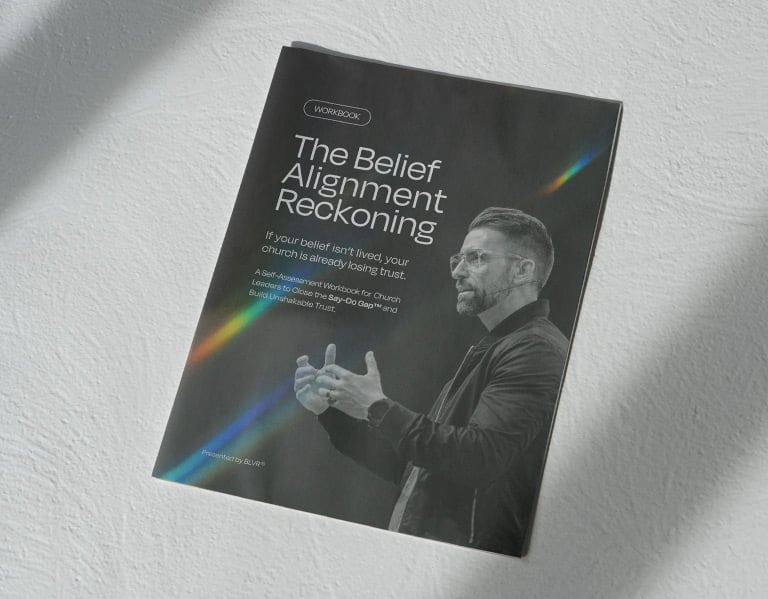
Church Branding / BY Scott Hancock
Your Church Doesn’t Need Better Marketing—It Needs More Integrity
Published On 07.29.2025
A 4-Step Framework to Align What You Say with What People Actually Experience
Integrity Isn’t Optional Anymore
You’ve felt it—maybe even said it out loud.
- People are leaving, and you’re not sure why.
- Your vision feels clear, but the culture doesn’t reflect it.
- Volunteers are burning out. Staff is misaligned.
- Sunday runs well, but something feels… off.
You’ve tried new programs. Clearer communication. Better systems.
But none of it will work if this deeper issue isn’t addressed:
What your church says it believes—and what people actually experience—don’t match.
And to be clear—we’re not talking about your theology.
We’re talking about your church’s guiding belief: the specific, convictional purpose that shapes how you show up, make decisions, serve people, and lead culture.
It’s not just what you believe theologically—it’s how that belief takes shape practically, in the lived experience of your church.
This is more than a communications problem.
It’s an integrity problem.
And the cost isn’t just aesthetic—it’s eternal.
Today’s world doesn’t take your word for it.
It watches what you do.
It listens with its eyes.
And it decides whether you can be trusted.
That’s why this post isn’t about rebranding—it’s about realignment.
Because when belief becomes behavior, trust follows.
And trust is what unlocks transformation.
A Belief-Driven Framework for Church Integrity
How to close the Say‑Do Gap® and build a church people can believe in again.
1. Declare It
Clarity before creativity.
Before you can live your belief, you have to define it.
What does your church actually believe—beyond doctrinal statements or borrowed vision decks?
What conviction anchors your mission?
What values shape your discipleship?
What unique belief defines how you see God, people, and purpose?
These aren’t just words for a website—they’re the foundation of your culture.
If they only exist in a binder, they won’t shape behavior.
And if nobody owns them, they won’t drive decisions.
Start here: Define your belief. Declare it clearly. Make it everyone’s responsibility to live it.
2. Diagnose It
What people feel is more powerful than what they’re told.
Put yourself in the shoes of a first-time guest, a skeptical seeker, or a young adult returning after years away.
Walk through your Sunday experience with their eyes.
What does your signage say?
How are people welcomed?
What kind of language is used on stage?
What values are felt in the lobby, the worship set, the prayer team?
Now ask yourself:
What would someone assume we believe based only on what they experienced today?
Where belief and behavior misalign, trust breaks.
So identify the friction.
Name the disconnects.
Own the Say‑Do Gaps.
Then do the brave work of addressing them.
3. Design It
If you really believed it, how would it shape everything?
Alignment isn’t accidental—it’s architectural.
Once you’ve declared what you believe and diagnosed the disconnects, start designing from that belief.
Let it guide how you plan, how you lead, how you spend, and how you serve.
Ask bold questions:
- If we really believed what we say, how would we…
- Greet someone at the door?
- Structure staff meetings?
- Invest our budget?
- Measure success?
- Handle conflict?
Perfection isn’t the goal.
Intentionality is.
Because integrity isn’t about getting everything right—it’s about aligning everything you can.
4. Demonstrate It
Your culture is built on what you consistently do—not what you occasionally say.
People trust what they can see, not just what they’re told.
So let your belief show up—on purpose, and on repeat.
From the pulpit to the parking lot…
From worship planning to volunteer training…
From budget meetings to baptism stories…
Ask:
- What behaviors reinforce what we believe?
- What stories are we celebrating?
- What systems are backing up our values?
Culture doesn’t grow from vision statements.
It grows from consistent demonstration.
So if it matters, make it visible.
Challenge to Act: Audit Your Sunday
This week, gather your staff or key leaders and walk through your Sunday experience with fresh eyes.
Then ask three courageous questions:
- What do we say we believe?
- What do people actually experience?
- Where is there a disconnect?
Circle the Say‑Do Gaps.
Then commit to closing them—not for optics, but for integrity.
This Isn’t About Optics. It’s About Integrity.
Your brand isn’t what you say.
It’s what people trust after they’ve seen you live it.
Churches don’t lose trust because of bad logos or outdated websites.
They lose trust because the message and the experience don’t match.
You don’t need a trendier aesthetic.
You need deeper alignment.
You don’t need to say more.
You need to live what you say—and let people see it.
When belief becomes behavior, trust follows.
And where there’s trust, there’s transformation.
Key Takeaway
Your brand isn’t what you say—it’s what you live.
Find Where Trust Is Breaking—In Under An Hour.
Free, fillable workbook to spot your Say-Do Gap™, see your trust zone, and choose one 30-day change.
Instant download + emailed link. PDF · 45–60 minutes. No spam.

About the Author

Scott Hancock
Partner / CEO
Scott Hancock is a thought leader in belief-driven branding and an expert in closing the Say-Do Gap®—the critical divide between what brands say and what they actually do. As CEO of BLVR®, Scott has pioneered a belief-led approach that helps organizations transform their core conviction into bold actions that inspire trust, loyalty, and market leadership.
With a reputation for pushing brands to go beyond surface-level promises, Scott’s work has been recognized by AdWeek, Forbes, and Fast Company for its fearless creativity and impactful results. His leadership has empowered BLVR® to become a trusted partner for purpose-driven brands seeking to align their actions with their core belief and create lasting change.




